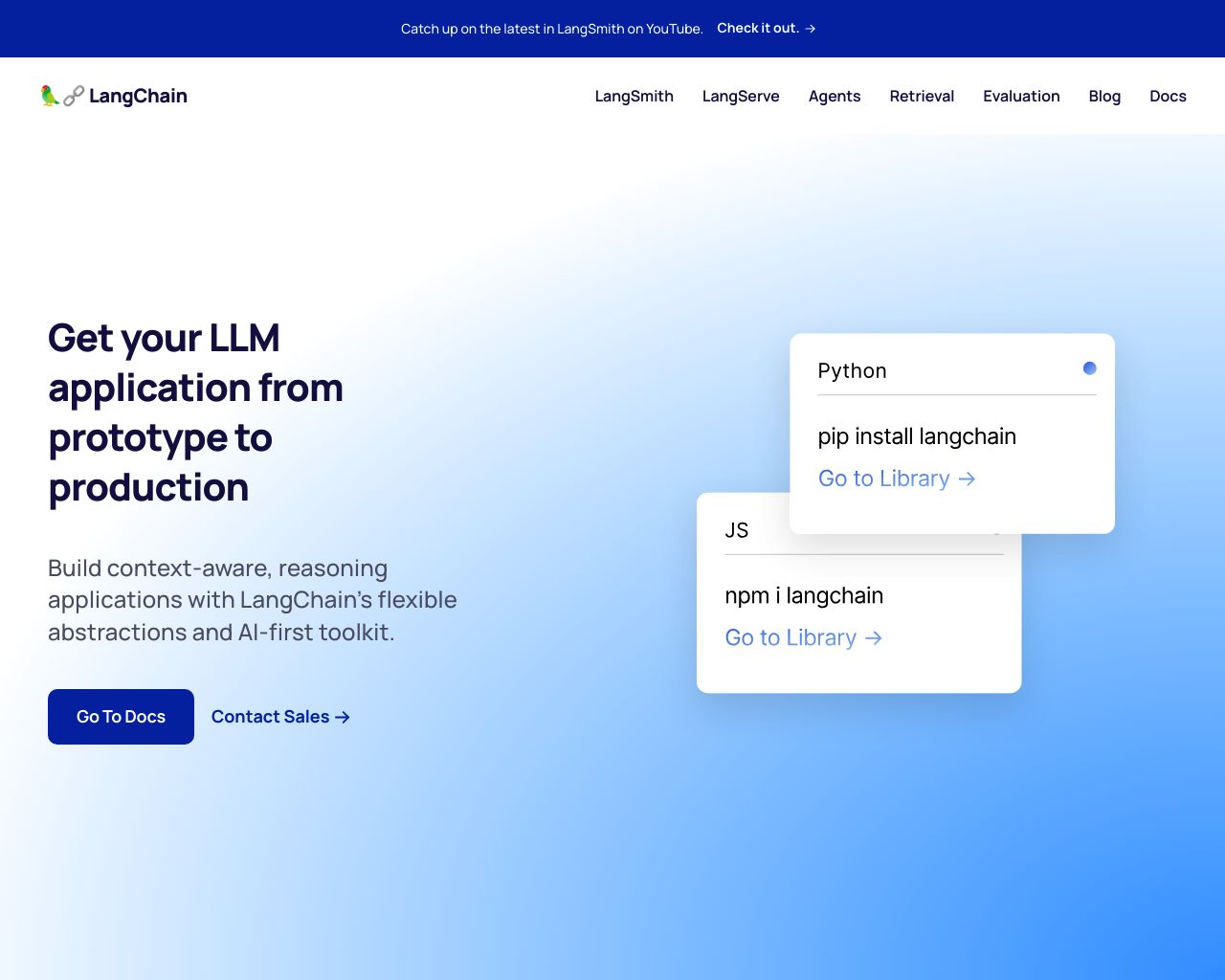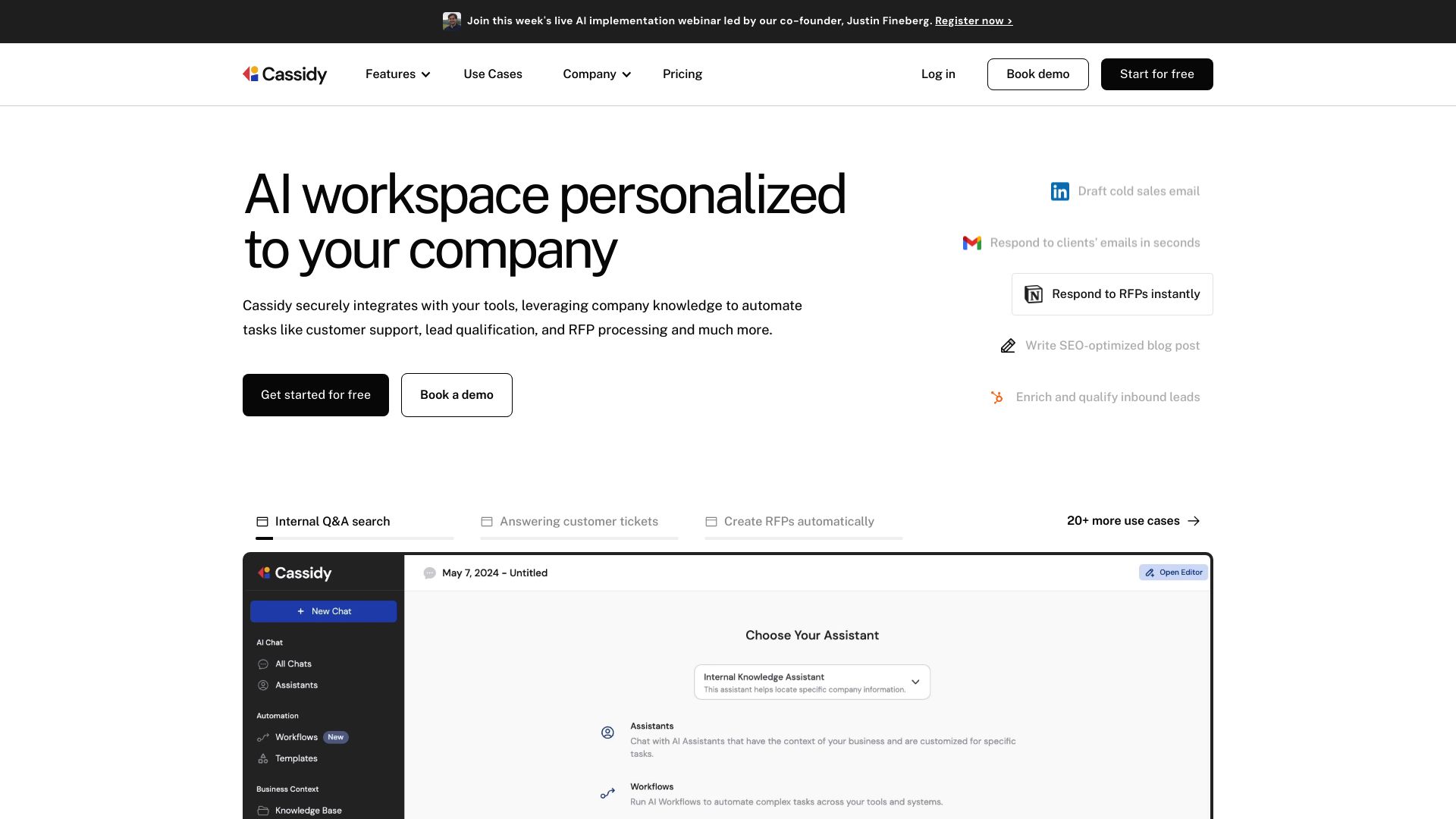LangChain vs. Cassidy: AI Development Platforms Compared
AI development platforms are revolutionizing how businesses leverage advanced technologies. LangChain vs. Cassidy, and SmythOS each offer unique approaches to building and deploying AI solutions. This comparison explores their key features, strengths, and limitations to help you choose the right platform for your needs.
We’ll examine how LangChain’s comprehensive framework for developers contrasts with Cassidy’s user-friendly automations, and how SmythOS combines powerful capabilities with accessibility. Whether you’re a seasoned developer or a business leader seeking to harness AI, this review provides insights into each platform’s integration capabilities, security features, and overall value proposition.
LangChain Overview
LangChain revolutionizes the development of applications powered by large language models (LLMs). This open-source framework simplifies the creation, deployment, and management of sophisticated AI agents, offering a comprehensive suite of tools for developers and businesses alike.
At its core, LangChain provides modular building blocks and third-party integrations that streamline the LLM application lifecycle. Developers can leverage LangGraph for creating stateful, multi-actor applications, while LangSmith offers powerful tools for debugging, testing, and monitoring. For production environments, LangGraph Cloud transforms LangGraph applications into robust APIs and assistants, ensuring seamless deployment.
LangChain revolutionizes the development of applications powered by large language models (LLMs). This open-source framework simplifies the creation, deployment, and management of sophisticated AI agents…
LangChain excels in its flexibility and extensive feature set. The framework supports various components, including chat models, LLMs, prompt templates, and vector stores. It also introduces the LangChain Expression Language (LCEL), enabling declarative chaining of components with optimized execution and first-class streaming support. This approach significantly enhances developer productivity and application performance.


While LangChain offers a powerful toolkit, it primarily caters to developers with some coding experience. The platform lacks a visual builder or no-code editor, which may limit accessibility for non-technical users. However, its extensive documentation and active community partially mitigate this limitation, providing resources for users to learn and overcome challenges.
LangChain’s integration capabilities stand out as a major strength. The framework supports a wide array of third-party tools and APIs, allowing developers to incorporate various data sources, AI models, and external services into their applications. This flexibility enables the creation of highly customized and feature-rich AI solutions tailored to specific business needs.
Cassidy Overview
Cassidy specializes in creating AI automations and assistants tailored to specific business needs. The platform securely integrates with existing tools and leverages company knowledge to automate tasks like customer support, lead qualification, and RFP processing. This personalization enhances productivity by equipping AI assistants and workflows with full context specific to each business.
Cassidy specializes in creating AI automations and assistants tailored to specific business needs. The platform securely integrates with existing tools and leverages company knowledge to automate tasks…


Cassidy’s model-agnostic approach allows users to employ any foundational AI model, future-proofing AI strategies. The platform seamlessly integrates with various data sources, including Google Drive, Slack, and Notion. Enterprise-grade security ensures data confidentiality by never using client data for model training.
A standout feature of Cassidy is its user-friendly workflow builder. The no-code, drag-and-drop interface enables users to construct complex AI automations without extensive programming knowledge. This accessibility democratizes AI development, allowing non-technical professionals to harness AI power for enhancing productivity and operational efficiency.
A standout feature of Cassidy is its user-friendly workflow builder. The no-code, drag-and-drop interface enables users to construct complex AI automations without extensive programming knowledge.
Cassidy also offers browser extensions, bringing AI capabilities directly into web applications like LinkedIn and email clients. This integration extends the reach of AI assistance beyond dedicated platforms, enhancing user productivity across various online environments.
While Cassidy excels in customization and integration, it lacks some features found in more comprehensive platforms. The absence of a hosted vector database and specific crawling capabilities for sitemaps, YouTube transcripts, or URLs may limit its applicability in certain data-intensive scenarios. Additionally, the platform doesn’t explicitly mention support for deploying AI agents as APIs or webhooks, which could be a drawback for developers seeking more flexible deployment options.
Feature Comparison
LangChain and Cassidy offer distinct approaches to AI development, with notable differences in their core components and security features. LangChain excels in providing a comprehensive framework for building language model applications, offering tools like LangGraph for creating stateful, multi-actor systems. It supports various AI models and includes LangSmith for debugging and monitoring. However, LangChain lacks a visual builder or no-code editor, which may pose challenges for non-technical users.
Cassidy, on the other hand, focuses on creating customized AI automations and assistants tailored to specific business needs. Its standout feature is a user-friendly workflow builder with a no-code, drag-and-drop interface, making AI development accessible to a broader audience. Cassidy also offers robust integration capabilities with existing tools and data sources. However, it doesn’t provide some advanced features like a hosted vector database or specific crawling capabilities for sitemaps and YouTube transcripts, which LangChain supports through its extensive integrations.
In terms of security, both platforms emphasize data protection, but their approaches differ. LangChain supports OAuth for API authentication and follows security best practices, likely including data encryption. Cassidy highlights its enterprise-grade security, ensuring data confidentiality by never using client data for model training. However, neither platform explicitly mentions features like IP control or constrained alignment, which could be critical for certain enterprise deployments.
Feature Comparison Table
| LangChain | Cassidy | SmythOS | |
|---|---|---|---|
| CORE FEATURES | |||
| Visual Builder | ❌ | ✅ | ✅ |
| No-Code Options | ❌ | ✅ | ✅ |
| Autonomous Agents | ✅ | ❌ | ✅ |
| Explainability & Transparency | ✅ | ❌ | ✅ |
| Multimodal | ✅ | ❌ | ✅ |
| Multi-Agent Collaboration | ✅ | ❌ | ✅ |
| Audit Logs for Analytics | ✅ | ❌ | ✅ |
| Agent Work Scheduler | ❌ | ✅ | ✅ |
| SECURITY | |||
| Constrained Alignment | ❌ | ✅ | ✅ |
| IP Control | ❌ | ❌ | ✅ |
| COMPONENTS | |||
| Huggingface AIs | ✅ | ❌ | ✅ |
| Zapier APIs | ❌ | ✅ | ✅ |
| Classifiers | ✅ | ❌ | ✅ |
| Data Lakes | ❌ | ❌ | ✅ |
| DEPLOYMENT OPTIONS (EMBODIMENTS) | |||
| Deploy as Webhook | ❌ | ✅ | ✅ |
| Staging Domains | ❌ | ❌ | ✅ |
| Production Domains | ❌ | ❌ | ✅ |
| API Authentication (OAuth + Key) | ✅ | ❌ | ✅ |
| Deploy as Site Chat | ✅ | ❌ | ✅ |
| Deploy as Scheduled Agent | ❌ | ✅ | ✅ |
| Deploy as GPT | ✅ | ❌ | ✅ |
| DATA LAKE SUPPORT | |||
| Hosted Vector Database | ❌ | ❌ | ✅ |
| Sitemap Crawler | ❌ | ❌ | ✅ |
| YouTube Transcript Crawler | ❌ | ❌ | ✅ |
| URL Crawler | ❌ | ❌ | ✅ |
| Word File Support | ❌ | ✅ | ✅ |
Best Alternative to LangChain and Cassidy
SmythOS stands out as our superior alternative to LangChain and Cassidy in the realm of agentic AI automation platforms. We’ve designed SmythOS to address the limitations of competing solutions while offering unparalleled ease of use, an extensive feature set, and unlimited use cases.
Our visual drag-and-drop interface empowers users of all technical backgrounds to create sophisticated AI agents without writing code. This democratization of AI development sets SmythOS apart from LangChain’s more developer-focused approach. While Cassidy offers a no-code option, SmythOS takes it further by combining intuitive design with advanced capabilities usually reserved for code-heavy platforms.
SmythOS excels in multi-agent collaboration and autonomous operation, features notably absent in Cassidy’s offering.
SmythOS excels in multi-agent collaboration and autonomous operation, features notably absent in Cassidy’s offering. Our platform enables the creation of complex, interconnected AI systems that can work together to solve intricate problems — a capability that outpaces both LangChain and Cassidy. This collaborative functionality opens up possibilities for automating entire workflows and business processes that would be challenging to implement with our competitors’ tools.
We’ve prioritized enterprise-grade security and scalability in SmythOS, addressing critical gaps in both LangChain and Cassidy’s offerings. Our platform includes advanced features like IP control and constrained alignment, ensuring that AI agents operate within defined parameters and maintain data integrity. These security measures, combined with our hosted vector database and support for various data formats, provide a robust foundation for building AI solutions that can grow with your business needs.
Unlike LangChain and Cassidy, SmythOS offers a comprehensive suite of deployment options.
Unlike LangChain and Cassidy, SmythOS offers a comprehensive suite of deployment options. We support deployment as APIs, webhooks, scheduled agents, and even as GPT models. This versatility ensures that AI agents built on our platform can integrate seamlessly into existing systems and workflows, regardless of the specific requirements or constraints of your project. By offering this level of flexibility, we empower users to leverage AI in ways that precisely fit their unique use cases, from enhancing customer interactions to automating complex backend processes.
Conclusion
LangChain, Cassidy, and SmythOS each bring unique strengths to AI development and deployment. LangChain excels with its comprehensive framework and tools like LangGraph, catering to developers seeking deep customization. Cassidy shines in its user-friendly approach, offering a no-code workflow builder that democratizes AI automation for businesses.
Yet, SmythOS emerges as the superior choice, combining the best of both worlds. We offer an intuitive drag-and-drop interface alongside powerful development tools, making AI accessible to both technical and non-technical users. Our platform’s ’Create Once, Deploy Anywhere’ philosophy, coupled with support for over 300,000 integrations, provides unparalleled flexibility and scalability.
While LangChain and Cassidy have their merits, SmythOS stands out with its comprehensive feature set. From multimodal interactions to problem-solving capabilities, and from hosted vector databases to advanced security measures like constrained alignment and data encryption, we cover all bases. Our platform not only simplifies AI development but also ensures enterprise-grade security and scalability.
To experience the future of AI development and deployment, we invite you to explore our diverse range of AI-powered agent templates. These templates offer a quick start to revolutionizing your workflow across various business functions. Ready to take the next step? Create a free SmythOS account and start building AI agents with no time limit. Discover how SmythOS can transform your approach to AI, making it faster, more accessible, and infinitely more powerful.
Last updated:
Disclaimer: The information presented in this article is for general informational purposes only and is provided as is. While we strive to keep the content up-to-date and accurate, we make no representations or warranties of any kind, express or implied, about the completeness, accuracy, reliability, suitability, or availability of the information contained in this article.
Any reliance you place on such information is strictly at your own risk. We reserve the right to make additions, deletions, or modifications to the contents of this article at any time without prior notice.
In no event will we be liable for any loss or damage including without limitation, indirect or consequential loss or damage, or any loss or damage whatsoever arising from loss of data, profits, or any other loss not specified herein arising out of, or in connection with, the use of this article.
Despite our best efforts, this article may contain oversights, errors, or omissions. If you notice any inaccuracies or have concerns about the content, please report them through our content feedback form. Your input helps us maintain the quality and reliability of our information.
